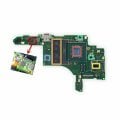Hi im new to this so i was looking for some insight iv read that sometimes a capacitor grounded on both sides is usually the chip but is there any diagrams that show what chip goes to what cap? I checked the charge amps and i get 0 amps and found a bad cap to the right of the coil by the charge port. would i be correct in thinking that the chip next to the coil is the chip that could be bad? also i will take the cap off to make sure it is not the cap.
Last edited by slimh22,











